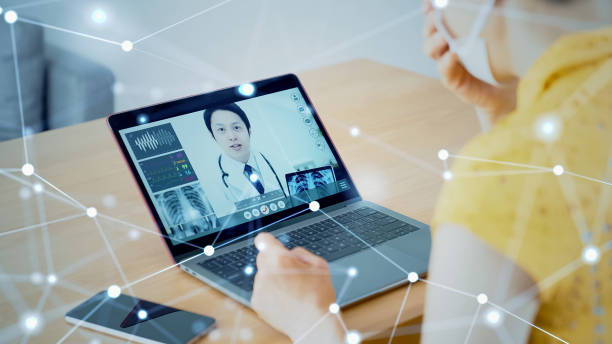Top Remote Patient Monitoring Platform: Streamline Health Care Procedures
Top Remote Patient Monitoring Platform: Streamline Health Care Procedures
Blog Article
The Future of Health Care: Remote Patient Checking Simplified
As healthcare remains to evolve, one location that holds immense assurance is remote person tracking. The principle of simplifying this procedure with technological developments is reshaping the means care is supplied and gotten. With a concentrate on boosting person end results and streamlining healthcare delivery, remote monitoring is positioned to change the industry. By exploring the advantages, technological innovations, and future trends in this area, we can get useful insights into the transformative potential of remote client monitoring.
Benefits of Remote Person Monitoring
Remote individual monitoring provides a multitude of benefits for both medical care suppliers and people alike. Additionally, remote individual tracking enhances the overall quality of care by providing a much more thorough and holistic sight of people' wellness condition beyond conventional in-person brows through.
Furthermore, remote client monitoring can lead to improved individual results and complete satisfaction. Remote tracking can minimize the need for constant health center sees, lowering medical care prices for both suppliers and patients.
Modern Technology Driving Remote Monitoring
In the realm of contemporary healthcare, technological advancements play a critical role in driving the advancement and performance of remote client surveillance. The assimilation of cutting-edge technologies such as wearable tools, mobile applications, and cloud-based systems has actually revolutionized the method doctor remotely monitor and take care of individual health - remote patient monitoring software. These technologies enable continual real-time tracking of essential indications, drug adherence, and other vital health information, permitting prompt interventions and individualized care plans
One key technology driving remote surveillance is the Web of Things (IoT), which makes it possible for seamless connectivity between medical devices and healthcare systems. IoT gadgets such as smartwatches and wireless sensing units transmit and gather individual data to central systems, facilitating remote tracking from throughout the globe. Artificial intelligence (AI) and machine understanding formulas better enhance remote tracking by analyzing substantial quantities of client data to find patterns, predict health and wellness patterns, and sharp doctor to possible concerns.
Influence on Medical Care Distribution
With the assimilation of sophisticated technologies driving remote client surveillance, the impact on medical care delivery is becoming significantly profound and transformative. Remote patient monitoring allows doctor to supply more personalized and aggressive treatment to clients, resulting in enhanced wellness results and minimized medical facility admissions. By remotely tracking important signs, signs and symptoms, and medicine adherence, health care professionals can intervene early, avoiding problems and improving the overall top quality of treatment.
Moreover, remote monitoring boosts access to healthcare services, specifically for individuals in rural or underserved areas. Individuals can receive constant tracking and support from their homes, removing the demand for regular in-person sees. This not only saves time and lowers costs for both patients and health care facilities but also minimizes the danger of direct exposure to contagious conditions, an important consideration in the current healthcare landscape.
In addition, remote client surveillance enables healthcare suppliers to much better prioritize and allot sources treatment based upon real-time data. By identifying risky people and stepping in quickly, medical care shipment comes to be more reliable and efficient, eventually bring about a much more sustainable and patient-centered healthcare system.
Improving Patient Outcomes

Furthermore, RPM permits positive management of persistent conditions, lowering the possibility of acute worsenings and medical facility readmissions. Individuals gain from raised ease and convenience, as they can get treatment in their own homes while remaining linked to their healthcare companies. This continual surveillance not just improves person satisfaction but also fosters a feeling of empowerment and involvement in their own wellness monitoring.
Future Trends in Remote Monitoring
Accepting innovative technologies in remote patient surveillance is forming the future landscape of health care shipment. The future fads in remote surveillance are anticipated to transform the way medical care is supplied, making it much more patient-centric and effective. One substantial pattern is the increased use wearable gadgets and sensing units to accumulate real-time data, allowing doctor to keep an eye on individuals continuously without the requirement for regular in-person gos to. These tools can track vital indications, drug adherence, and task degrees, offering a detailed view of the individual's health and wellness status.

Furthermore, telehealth systems are coming to be much more advanced, permitting digital assessments, remote diagnosis, and remote individual checking all in one incorporated system (software for remote patient monitoring). This all natural approach to remote monitoring is improving medical care shipment, improving individual contentment, and inevitably, enhancing overall quality click over here of treatment
Final Thought
To conclude, remote individual surveillance offers countless advantages in medical care distribution, driven by innovations in technology. It has the potential to improve client outcomes and revolutionize the method health care is provided. Future fads in remote tracking will proceed to form the landscape of healthcare, giving chances for even more efficient and tailored individual care.
Remote patient tracking presents a plethora of advantages for both healthcare providers and patients alike. Additionally, remote individual monitoring improves the total high quality of care by giving a more thorough and all natural click to read view of people' health and wellness status beyond traditional in-person visits.
Furthermore, remote person surveillance can lead to improved client end results and fulfillment. Remote person tracking enables health care service providers to use more individualized and positive treatment to individuals, leading to improved health and wellness results and decreased medical facility admissions. Remote individual tracking (RPM) plays a considerable function in enhancing patient results by supplying constant, real-time data that allows medical care service providers to interfere promptly and change therapy strategies as required.
Report this page